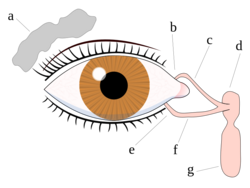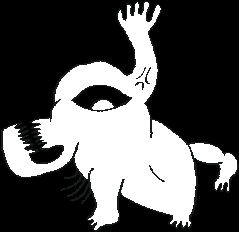White Desert (Naraka (Buddhism))
須弥山世界(仏教における、人間界を含む宇宙の全て)の一番外側を輪のように取り囲む鉄囲山(てっちせん)は内と外の二重構造であり、その間に地獄や閻魔王宮があるとしている。
鉄囲山 (The mountain of the iron to enclose) in the 須弥山世界 (all the universes in Buddhism including a human community) which encloses the outside like a ring most is the dual structure of inside and outside, and supposes that there are hell and a Yama king's palace between them.
※White Desert's Mountain(鉄囲山) The Thing with the Quivering Jaw(Yama)?
つまり、現在の通説である地獄=地下世界とは異なり、いわゆる「世界の果て」にあるとしているのだ。
That is, unlike the hell = underground world which is the present accepted theory, it is supposed that it is in what is called "an end in the world."
※Hell (八熱地獄 is underground world hell) and White Desert (長阿含経 is end in the world hell)
The Thing with the Quivering Jaw (Tears)
Main article: List of eye diseases and disordersQuality of vision is affected by the stability of the tear film.[5]
"Crocodile tears syndrome" is an uncommon consequence of nerve regeneration subsequent to Bell's palsy or other damage to the facial nerve in which efferent fibers from the superior salivary nucleus become improperly connected to nerve axons projecting to the lacrimal glands, causing one to shed tears (lacrimate) during salivation while smelling foods or eating. It is presumed that one would also salivate while crying due to the inverse improper connection of the lacrimal nucleus to the salivary glands, but this would be less noticeable.[6]
The Thing with the Quivering Jaw (Crocodile tears)
Crocodile tears (or superficial sympathy) are a false or insincere display of emotion such as a hypocrite crying fake tears of grief. The phrase gives its name to Bogorad's syndrome, colloquially "crocodile tears syndrome", an uncommon consequence of recovery from Bell's palsy where faulty regeneration of the facial nerve causes sufferers to shed tears while eating.[citation needed]
The Thing with the Quivering Jaw (Crocodilia)
Teeth and jaws
All crocodilians have thecodont dentition (teeth set in bony sockets), but unlike mammals, they replace their teeth throughout life (though not in extreme old age). Juvenile crocodilians replace teeth with larger ones at a rate as high as one new tooth per socket every month. After reaching adult size in a few years, however, tooth replacement rates can slow to two years and even longer. Very old members of some species have been seen in an almost "edentulous" (toothless) state, after teeth have been broken and replacement slowed or ceased. As a result, a single crocodile can go through at least 3,000 teeth in its lifetime. Each tooth is hollow, and the new one grows inside the old. In this way, a new tooth is ready once the old is lost.
The Thing with the Quivering Jaw (Chest hair)
Although vellus hair is already present in the area in childhood, chest hair is the terminal hair that develops as an effect of rising levels of androgens (primarily testosterone and its derivatives) due to puberty. Different from the head hair it is therefore a secondary sexual characteristic. Men tend to be covered with far more terminal hair, particularly on the chest, the abdomen, and the face.
The development of chest hair begins normally during late puberty, usually between the ages of 15 and 18. It can also start later, between the age of 20 and 30, so that many men in their twenties have not yet reached their full chest hair development. The growth continues subsequently.
※The Thing with the Quivering Jaw (Chest hair) is "Men tend to be covered with far more terminal hair" and "usually between the ages of 15 and 18. It can also start later, between the age of 20 and 30"







